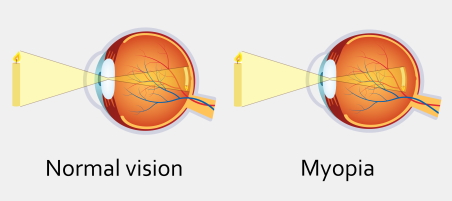Kanohi pātata Short-sightedness (myopia)
About myopia
In normal vision, the cornea (the front of your eye) and lens make sure light focuses on your retina (the light-sensitive layer at the back of your eye).
If you have myopia, your cornea is curved too much, or your eyeball is too long. This means your focus falls in front of your retina, instead of on your retina.

When the image focuses in front of your retina, the image on the back of your eye is not as sharp as it should be. Things get more blurred the further away they are.
Myopia usually starts in childhood, gets worse, then levels off in your mid-20s. Some people develop myopia in middle age, even if they have not had problems with their vision during their childhood.
Because distance vision can gradually become blurred, tamariki (children) might not realise they do not see as clearly as other people.
People with uncorrected myopia will often frown and squint as they try to see better, and this may cause headaches.
Causes of myopia
Certain risk factors may increase the likelihood of developing near-sightedness.
- If one of your parents is short-sighted, your risk of developing the condition is increased. The risk is higher if both parents are short-sighted.
- Prolonged reading or other close-up activities.
- Screen time — tamariki who use computers or smart devices for long periods have a greater risk of developing short-sightedness.
- Lack of time spent outdoors.
Diagnosing myopia
If poor vision stops you doing things you enjoy and makes it difficult to see things at a distance, you should see your optometrist for an eye examination.
Treating myopia
All treatments for myopia adjust your focus precisely on your retina (rather than in front of it). Corrective lenses (glasses and contact lenses) change the way light focuses into your eye, while refractive surgery reshapes the surface of your eye so light focuses on the retina.
Wearing glasses or contact lenses will not make your eyes weaker, although people often feel they need them more as they become used to seeing things more clearly and feeling more comfortable. It is very important for some young tamariki to wear glasses, as it helps their vision to develop normally.
Glasses
Prescription glasses shift the point of focus so that it falls exactly on the back of your eye, giving you clear vision. You may need more correction in one eye than the other. Your optometrist can discuss this with you as they evaluate which treatment is best suited to your myopia.
Contact lenses
There are many different types of contact lenses available, in both hard (rigid, gas permeable) and soft (usually disposable) materials. They include options for extended wear and multifocal prescriptions. Ask your optometrist which ones will be best for you.
Ortho-K
Orthokeratology, or Ortho-K, treats your myopia with rigid contact lenses you wear overnight to reshape the curve of your eye. Once you have achieved acceptable vision, you may be able to wear the lenses slightly less often, but if you stop wearing them altogether your eyes will go back to their original shape and your myopia will return. Your optometrist will be able to tell you if this treatment is suitable for you.
Refractive surgery
Refractive surgery can permanently reshape the surface of your eye using methods such as LASIK, PRK and LASEK. Ask your optometrist for more information. They can assess your suitability for surgery and refer you to a specialist eye surgeon if appropriate.
Clinical review
This content was written by HealthInfo clinical advisers. It has been adapted for Health Information and Services.